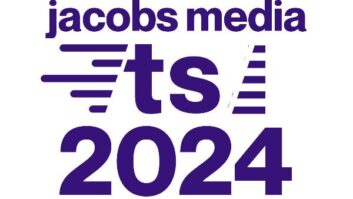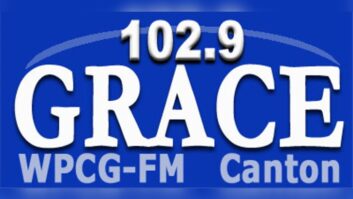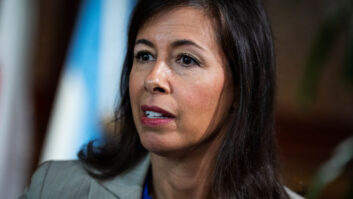WASHINGTON
Radio broadcasters and broadcast advocates claim that some of the FCC’s localism proposals are onerous, particularly for smaller broadcasters, and in some cases could force stations off the air in overnight periods.
The commission’s Report on Broadcast Localism touches on nine broad issues, including some recommendations to address what the commission believes are “deficiencies” of many broadcasters in serving their local communities.
The recommendations include requiring stations to establish permanent advisory boards and to carry a mandatory amount of public service programming.
Specifically troubling to broadcasters are the tentative conclusions that radio stations be attended 24/7 and that main studios must be located in the designated community of license.
Radio proponents say some small- and medium-market radio stations are unstaffed during overnight hours because of budget constraints; and in many instances main studios, in small and large markets, are located outside the city of license.
Survival
Broadcaster support for any part of the FCC’s report is hard to find.
Some broadcasters feel the call for local advisory boards is a good idea; but others claim the FCC’s wording is vague on what broadcasters will have to do with board recommendations.
“Small-market broadcasters already reach out to the community,” said Jon Yinger, owner of Broadcast Properties LLC, which owns nine radio stations.
“To survive in today’s market you must localize your radio stations. My fear is that we will be required to follow the advisory board’s recommendations.”
Yinger’s stations offer religious programming; he says advisory board recommendations could force him to offer programming that would be at odds with Christian faith.
The FCC specifically mentions “the development of balanced and community responsive programming that includes all significant groups with specials interests and needs” in its report.
So opposed is Yinger to the FCC’s localism reform that he, with help from law firm Fletcher, Heald & Hildreth, has launched Web sites www.helpradionow.com and www.savechristianradio.com. The sites list reasons the FCC wants more regulation and how broadcasters can make reply comments on the Notice of Proposed Rule Making.
The NAB wrote a strongly worded response to the FCC’s localism proposal when it was issued late last year. In it the broadcast trade association claimed the “proceeding carries grave First Amendment implications” and that in fact, “onerous regulations can have unintended consequence of reducing programming quality.”
Dennis Wharton, NAB’s executive vice president of communications, said, “There seems to be a disconnect between policymakers and how radio stations serve their communities. The one-size-fits-all regulation that sometimes comes from Washington doesn’t always accomplish what they hope it will.”
No more overnights?
The commission stated in its recommendations that many commenters, including some consumer groups, inferred it is increasingly difficult to get emergency information to the public late at night because many radio stations are unmanned and controlled from a remote location.
The FCC’s proceedings reaffirmed the importance the public places on timely and accurate emergency information on broadcast stations.
However, several small-market broadcasters told Radio World the FCC’s move to require radio stations be manned 24/7 ultimately could backfire on the commission by forcing some off the air overnight.
“I think that is what will happen rather than broadcasters paying for someone to be in the studio around the clock,” said Jay Mitchell, who until recently owned several small-market stations and is publisher of the Small-Market Radio Newsletter.
Many broadcasters have stringent emergency protocols and the technology to allow emergency alert messages to be broadcast instantaneously during off-hours, Mitchell said.
“You really don’t need someone in the studio 24/7. I’m afraid many small broadcasters would simply cut broadcast hours and be unable to afford to keep their stations on the air overnight if forced to hire additional manpower. Therefore, the FCC is considering options that would actually cut services in smaller markets,” Mitchell said.
Some wonder if the localism proposals are something of a trial balloon by the commission, intended to be a demonstration of what the commission could do if broadcasters don’t improve, said Womble Carlyle Sandridge & Rice communications attorney Peter Gutmann.
“Is this just a function of the bully pulpit, or are they serious about regulating some of these areas, and is there serious congressional pressure to get it done?” he asked.
Gutmann believes there is an appreciation among FCC commissioners for what radio broadcasters do day-to-day. But he senses the agency’s frustration with some broadcasters who do little local news and public affairs programming.
The FCC also has tentatively concluded it should introduce broadcast license renewal programming guidelines; broadcasters would be obligated to carry a certain number of hours of local public affairs programming to meet renewal criteria. Stations not meeting the requirements would then have their license renewals reviewed by the full commission, Gutmann said.
“That’s scary for broadcasters and certainly a big move toward re-regulation. The possibility of subjectiveness in the process is threatening to broadcasters,” Gutmann added.
What’s next?
Will the localism proposals be enacted?
Gutmann expects some or all of the proposals to be diluted before the FCC’s final rulemaking is issued.
Ownership diversity could also suffer from the added expense of additional regulation, Yinger of Broadcast Properties said.
“This would hurt women and minorities who want to enter broadcasting. It increases the cost of entry by increasing the cost of operating a radio station.”
Proponents of the FCC’s localism initiative contend the commission is right in taking broadcasters to task for their lack of local commitment.
“Commercial radio has largely ceded news and public affairs to non-commercial radio,” wrote Media Access Project President/CEO Andy Schwartzman in comments filed to the FCC. Media Access Project is a non-profit, public interest law firm based in Washington.
Free Press, which describes itself as a Washington-based nonpartisan organization working to reform media, supports the FCC’s localism mission, though the group thinks the recommendations should have gone farther.
“We think the FCC downplayed testimony from the public hearings regarding localism, which showed a major wave of consumer discontentment of media,” said Research Director Derek Turner.
“There needs to be major reform to ensure broadcasters take seriously their promise to reflect the views and address the concerns of their local communities in return for being granted a license to use the public airwaves.”
Turner said Free Press is pleased with the FCC’s recommendation to require radio stations post the majority of their public files on their Web sites, much the same as TV stations are now required to do.
“However, the license renewal process right now is broken. It will remain so until there is meaningful punishment for those stations that fail to meet localism obligations.”
Other consumer groups, like the Consumer Federation of America and Consumers Union, have filed hundreds of comments, mostly supporting the FCC’s actions on localism.
Broadcasters and interested parties can file comments regarding the FCC’s Notice of Proposed Rulemaking (MB Docket 04-233). Comments are due March 14.
Main Studio, 24/7 Staffing Raise Concerns
Radio engineering executives say they would be left scrambling if the FCC were to again require broadcasters to locate main studios in their community of license.
As part of the FCC’s Report on Broadcast Localism and subsequent Notice of Proposed Rule Making, the commission is revisiting its 1987 decree that allowed a station to locate its main studio anywhere within the station’s principal community contour.
The FCC’s tentative conclusion could be devastating to radio broadcasters who have spent millions of dollars building new facilities to house clusters of radio stations, which are often licensed to surrounding communities, engineers tell RW.
“Fewer than a half of our properties actually have main studios physically located in the designated community of license,” said Milford Smith, vice president of radio engineering for Greater Media. “Many of these facilities contain multiple radio stations and offices licensed to multiple communities and cost millions of dollars to construct.”
However, Smith finds it unlikely broadcasters would move entire studio operations if or when the FCC issues final rules requiring it.
“I suspect that we and many others in similar circumstances would establish a minimal ‘official’ studio where it physically needed to be to fulfill the requirements,” Smith said.
Sheridan Broadcasting Director of Engineering Bob Sharkey said, “This is not on our radar just yet, but if it does happen we would have to conform, which would amount to considerable expense.”
Sheridan Broadcasting owns six radio stations, none of which are housed in their city of license, Sharkey said.
Steve Davis, senior vice president, engineering and capital management for Clear Channel Radio, said the current rule regarding main studios has it right, calling the new proceedings “anti-localism.”
“It recognizes that the area a station serves is defined by that station’s city-grade signal contour. The rule allows for stations to locate studios in population centers,” Davis said.
In addition to costing broadcasters millions of dollars to relocate studio facilities, the FCC’s recommendations would also be a hardship for the majority of most stations’ listeners, Davis added.
“Locating in the population center makes it easier for listeners to interact with radio stations. Locating stations in sometimes remote, far-flung communities will reduce the contact most listeners have with a particular radio station,” Davis said.
As for 24/7 staffing, he feels the change would affect smaller broadcasters much more than a large radio group like Clear Channel.
“In most cases with multi-station clusters, there is at least one person on duty within our facilities at all times. But smaller broadcasters would certainly be faced with additional costs to have someone baby sit the radio station at all times.”
Greater Media’s Smith added, “I have a hard time understanding how employing a minimum wage person merely to establish a presence would contribute anything whatsoever over and above a proper functioning EAS system in an emergency situation.”
— by Randy J. Stine












